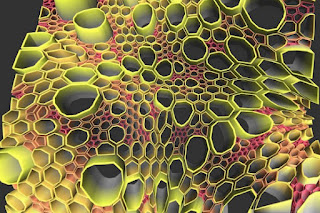Morgan Herrin, Untitled, dimensional lumber (2x4's), h: 82 x w: 18 x d: 12 in , 2008
The wood carved barnacles on that sculpture are quite astounding.
Alexander McQueen takes the patterns of barnacles and sculptural forms of barnacles as inspiration for a series of dresses like these below (both a fairly literal interpretation and then a more stylized, 2D print.
Nervous System (mentioned in the Radiolarians post) has also made some barnacle-inspired generative art (read more on their blog).
Ceramic artist Carol Gouthro has a veritable wunderkammer of ceramic vessels (of a botanical and zoological bent). The Aurlia gouthroii "Barnacles" vessel looks amazing.
Artist Lauren Kussro has created many sea-life multimedia. She has made some barnacle pieces by printing mulberry paper (monotype and screen printing), coating and waxing the paper, forming their shapes, sewing them together, embellishing with beads and hemming - which sounds tremendously labour-intense, but consider what she can create. This is called, “We held to each other so tightly, we became as one”.
Combining cherry and poplar wood veneers and paper, Andrew Kudless and the design studio he founded, MATSYS, digitally designed and fabricated (but hand-assembled) Chrysalis (III), inspired by cellular morphologies and barnacles. (↬the fox is black)
Chrysallis III, 2012, 190cm x 90cm x 90cm, Composite paper-backed wood veneers from Lenderink Technologies. Cherry veneer (exterior) and poplar veneer (interior).
Textile artist Helle Jorgensen creates magical ocean-inspired artwork. Consider some of her crocheted plastic(!) barnacles. (Be sure to check out her portfolio of marine creatures crocheted from plastic paper 'yarn'.)
Another textile artist who has crocheted (and embroidered) barnacles is Emily Barletta.
Pelt, 2007, crocheted yarn, 51 x 31 x 2 inches
Bean, 2007,crocheted yarn, 16 x 7 x 3 inches
The Manitoba Craft Museum houses this woven piece, called 'Prairie Barnacles' made to commemorate the 50th Anniversary of the Manitoba Crafts Guild in 1979.
Barnacles have made it into our homes. You can find pieces which are actually encrusted with real barnacles (on purpose) and pieces inspired by barnacles. This is a lovely porceline piece by Lilach Lotan Ceramic-Art, the Coral Tea-Light: Barnacles.
You can get ceramic wall barnacles from the knowhow shop.
 For the DIYer:
For the DIYer:Ellen McHenry provides instructions to make her pop-up barnacle, illustrating their anatomy, free for download here.
Design*sponge posted this DIY for paper clay barnacles.



























No comments:
Post a Comment